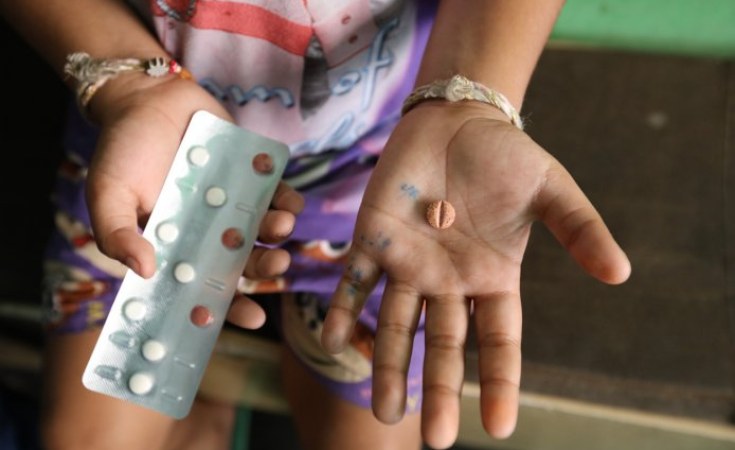Today, the World Health Organization (WHO) launched the third edition of the Roadmap towards ending TB in children and adolescents, along with partners and civil society. The roadmap outlines an ambitious five-year plan with 10 key actions to improve the prevention, treatment, and care of TB in children and adolescents.
Children and adolescents continue to experience a disproportionate burden of TB. WHO's recently released Global Tuberculosis Report, highlights that an estimated 1.25 million children and young adolescents (aged 0-14 years) fell ill with TB in 2022, which is 12% of the global TB burden. Almost half were under 5 years of age. In the same year, more than 200,000 children and young adolescents died due to TB, representing 16% of all TB deaths. Among deaths in HIV-negative children and young adolescents 76% occurred in children under the age of 5 years. Almost all the children and young adolescents who died of TB did not have access to treatment.
"It is unacceptable that hundreds and thousands of children and adolescents worldwide still do not have access to life-saving TB prevention, treatment and care", said Dr Tereza Kasaeva, Director of WHO's Global TB Programme. "The new Roadmap lays the groundwork for much needed actions over the next five years building on commitments made by world leaders at the 2023 UN High Level Meeting on TB, to close gaps in access to care and safeguard the rights of children and adolescents."
A stocktake of progress between 2018 and 2022 on targets set in the political declaration of the first United Nations high-level meeting on the fight against TB, highlights only 71% of the target to provide treatment to 3.5 million children and young adolescents was achieved (compared to 84% of the 40 million target for people of all ages). The gap for diagnosis and treatment is even greater, with an achievement of only 19% of the target to provide treatment for 115,000 children and young adolescents with MDR/RR-TB. This means that 4 in 5 children and young adolescents with MDR/RR-TB in the past 5 years did not access treatment.
While the target for the provision of TB preventive treatment (TPT) to 6 million people of all ages living with HIV was exceeded by 5 million, data are not available on the number of children and young adolescents that received TPT. About 1 in 2 TB contacts aged under 5 had access to TPT (2.2. million out of the 4 million target). In household contacts aged 5 years and above, only 10% of the 20 million target was achieved. These figures show that we need to accelerate our efforts to prevent and manage TB in children and adolescents.
Ciara Goslett, young MDR TB survivor from South Africa said: "Over 1 million children and young adolescents get sick with TB every year. I don't want them to go through the painful experience that I went through. I call on world leaders to act now and invest in implementing the most recent TB guidelines in their countries as fast as possible!"
The third edition of the Roadmap towards ending TB in children and adolescents has benefited immensely from the input of the members of the Child and Adolescent TB Working Group and its core team, country representatives, civil society and affected communities. It includes revitalized actions that are aligned with the targets of the political declaration of the second United Nations high level meeting on the fight against TB, which was convened in New York in September 2023.
The Roadmap highlights that between 2023 and 2027, 90% of the estimated number of people with TB should be reached with diagnosis and treatment services and 90% of people at high-risk of developing TB should be able to access TB preventive treatment. In addition, 100% of families should have access to a health and social benefits package to avoid financial hardship.
The key actions in the Roadmap call for: an increase in political leadership, multisectoral engagement and accountability and for sustained advocacy efforts; the closure of persistent policy-practice gaps; strengthening the implementation of integrated, people-, family- and community-centred strategies as part of primary health care; and, addressing persistent gaps in data and shortfalls in research and development. The ten key actions from the Roadmap are summarized in the figure below.
"The 2023 Roadmap highlights the need to accelerate progress and to effectively address the stubborn policy-practice gap that exists in many settings. To do this, a comprehensive and multisectoral approach is needed. This also requires stronger prioritization of children and adolescents at the country level as well as a focus on pregnant and postpartum women, which is a feature of the new Roadmap. The coordinated engagement of all relevant stakeholders and partners will be essential to achieve this," said Dr Moorine Sekadde-Kasirye, the incoming Chair of the Child and Adolescent TB Working Group
Implementation of the key actions in the Roadmap will rely on many factors, strong policies and political will are essential. In 2022, WHO issued consolidated policy recommendations and implementation guidance on the prevention and management of TB in children and adolescents with new recommendations on diagnostic approaches, treatment of drug-susceptible TB and TB meningitis and drug-resistant TB and models of TB care for children and adolescents affected by TB. National programmes are encouraged to adopt these latest recommendations aligned to the key actions in the Roadmap. To further build capacity of health care workers to effectively prevent and manage TB in children and adolescents, WHO will soon launch an e-course on the management of TB in children and adolescents, which will be available on the EndTB Channel, OpenWHO.
This edition of the roadmap builds on the previous versions of the Roadmap, launched in 2012 and 2018.


